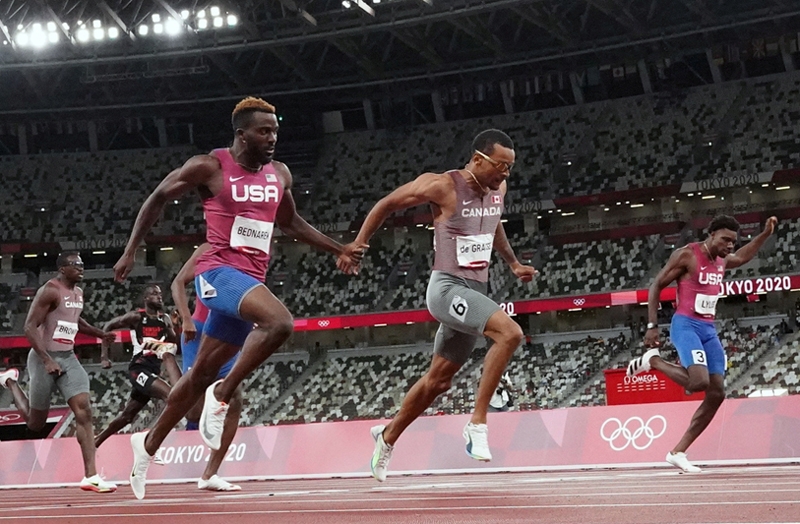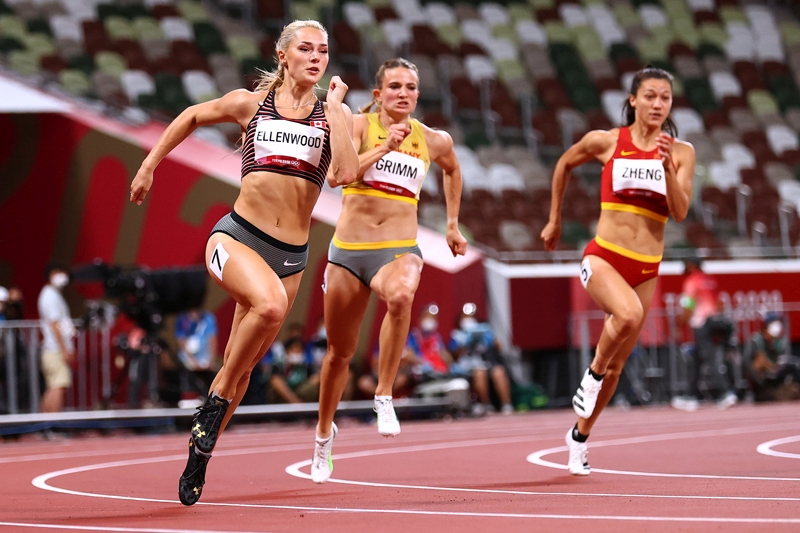You are viewing 1 of your 1 free articles. For unlimited access take a risk-free trial
Endurance performance: choosing high-intensity training wisely
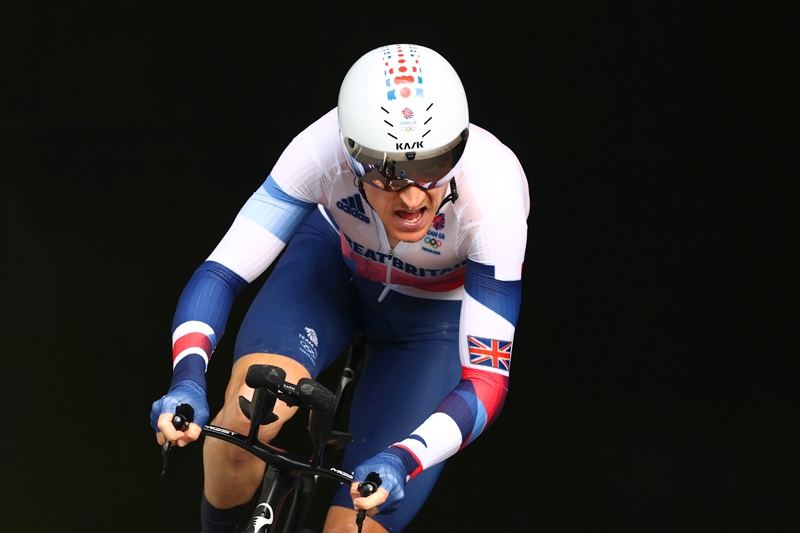
When endurance athletes become stuck in a performance rut, an increase in training intensity is often required. But how should this intensity be applied for greatest gains? SPB looks at the evidence
There’s an old maxim that states ‘if you do what you’ve always done, you’ll get what you’ve always had’. It sounds blindingly obvious of course but it’s surprising just how many athletes appear to be oblivious to this self-evident truth! The fact of the matter is that if you want to raise your performance to a higher level, you have to provide the appropriate training stimulus for this to occur.Getting intense
There are a number of ways that endurance athletes can induce a greater training stimulus, but they all involve some degree of high-intensity effort. One of the most popular and powerful training methods is interval training – repeated bursts of high-intensity effort interspersed with periods of rest of very low-intensity work. Used correctly, interval training sessions can increase the body’s oxygen transport capacity and the muscles’ ability to use that oxygen to produce energy (ie maximum oxygen uptake).Interval training can also improve ‘lactate tolerance’. In simple terms, this means muscles become more efficient at producing energy when oxygen is in short supply (ie at very high intensities) with the result that less of the fatiguing by-product of exercise called lactate is produced. Muscles also become better at breaking down any lactate that is produced, all of which means an athlete can work at higher intensity for longer – exactly what’s needed for setting a new PB.
However, interval training isn’t the only way of generating high-intensity effort. Another frequently used method is ‘threshold training’. This involves a sustained effort with a heart rate of around 80-85% of maximum (as a rough guide, your maximum heart rate is given by the formula 220 minus your age in years).
During threshold training, lactate levels are constantly elevated, though the effort level isn’t so high as to produce a constantly rising rate. One of the benefits of threshold training is that it enables an athlete to get a feel for his or her appropriate race pace, which, in shorter events will be slightly above threshold pace and in longer events, very close to threshold, rising slightly near the end of the race.
The value of intensity
An analysis of the intensity zones during a 40km cycling leg of an Olympic distance triathlon shows why intensity in training matters. This research showed that approximately 19% of the total cycling time was spent at around 100 % of maximal aerobic power (ie flat out!) and a further 14% of the time was spent in the lactate accumulation zone (around 85-100 % of maximal aerobic power)(1). Although this research looked at triathlon, the principle is equally applicable across all endurance competition.Adding intensity to a training program using intervals is one of the most popular methods used by endurance athletes, and studies show a wide range of combinations of interval durations and intensities can produce good gains in fitness(2). But just how effective is interval training in endurance athletes who already have high levels of fitness?
One study on triathletes provides a very useful insight(3). Scientists examined the effects of a 2-week high-intensity ‘shock microcycle’ (consisting of a number of interval sessions) in 16 triathletes. In particular, they wanted to see what effect this burst of interval training had on the triathletes’ oxygen consumption and exercise performance, and in addition, to establish whether periods of active rest (gentle exercise between each intense interval) were more beneficial than passive rest (complete rest between intervals).
Why the special interest in active vs. passive rest? Well, previous research has indicated that lactate accumulation during an intense interval actually stimulates beneficial endurance adaptations in the working muscles. Because active recovery clears lactate from muscles more rapidly than passive recovery, passive recovery between intervals exposes the muscles to higher levels of lactate for longer, and could therefore lead to greater and more long lasting muscle adaptations that are beneficial to endurance.
The triathletes were split into passive and active recovery groups and over the next 2 weeks, both groups performed a total of 15 high-intensity interval sessions (see box 1) in three discreet training blocks, each lasting three days (see figure 1). Before and one week after the final training session, athletes performed tests to determine maximum aerobic power, power output at lactate threshold and time trial performance.
Figure 1: Arrangement of the 15 interval sessions over the ‘shock microcycle’(3)
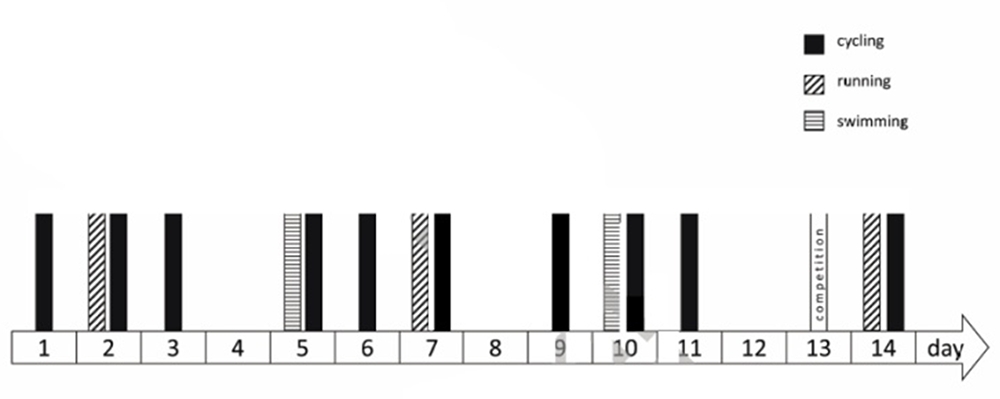
Box 1: Description of interval sessions
*Cycling intervals: four lots of 4-minute intervals at 90-95% max heart rate with 3 minutes of either active (60% max heart rate) or passive rest between;*Running intervals: ten lots of 40-second intervals at 90-95% heart rate max (repeated twice with a 10-minute gap in between each set). Active or passive rest (as above) for 20 seconds between intervals;
*Swimming intervals: six lots of 200m swims (at 90% of seasonal personal best time) separated by 2-minute active (~50 % of seasonal personal best time) or passive recovery periods.
The first key finding was that this 2-week burst of high intensity training improved the time trial performance and peak power output of all the triathletes in a short period of time, thus validating this ‘shock tactic’ approach. However, a closer look at the data also showed that intervals performed with passive recovery were significantly more effective at increasing the amount of power produced at lactate threshold. For example, average power output at lactate threshold rose from 231 to 251 watts in the passive recovery group but was virtually unchanged in the active recovery group.
The ‘power at lactate threshold’ measure is important because it’s crucial in determining how long you can sustain a high-intensity pace. These extra gains in the passive recovery group occurred despite the fact that passive recovery intervals resulted in a 20% lower total training volume (remember, the triathletes rested completely in between intervals).
Polarizing opinions
A valid question at this point is whether triathletes and other endurance athletes should stick to using intervals as the primary mode of boosting speed and performance? Few studies have investigated the long-term effects of different training regimes in endurance athletes but a very powerful study on a large group of endurance athletes including triathletes, cross-country skiers, runners and cyclists suggests that while intervals can play a role, an even better approach is possible(4).In this study, scientists compared four different approaches to endurance training in 48 trained endurance athletes over a 9-week period. These approaches were as follows:
- High-volumes of steady-state training (the default mode for many endurance athletes!)
- Threshold training
- ‘Polarized training’ (see box 2)
- Interval training (high-intensity intervals)
- Low intensity – heart rate kept below that required to produce a blood lactate value of 2mmol/L (equivalent to zone 1 according to polarized theory)
- Lactate threshold – heart rate elevated to produce a blood lactate value of 3–5mmol/L (equivalent to zone 2)
- High intensity – heart rate at or above 90% of maximum (equivalent to zone 3)
Box 2: Polarized training

The polarized theory of training uses the concept of ‘intensity zones’. Basically, this concept assigns your time spent training into three zones - 1, 2 and 3 - which refer to easy, moderately hard and very hard intensities of training respectively (see below). What’s fascinating is that studies on elite athletes such as runners and rowers suggest that the best way of achieving your maximum endurance potential is to spend the bulk of your training time in zone 1, ensure you spend at least some time in zone 3 but not to spend too much time in zone 2 (the moderately hard zone).
Figure 2: The 3-week sub cycle (repeated three times) for each mode of training
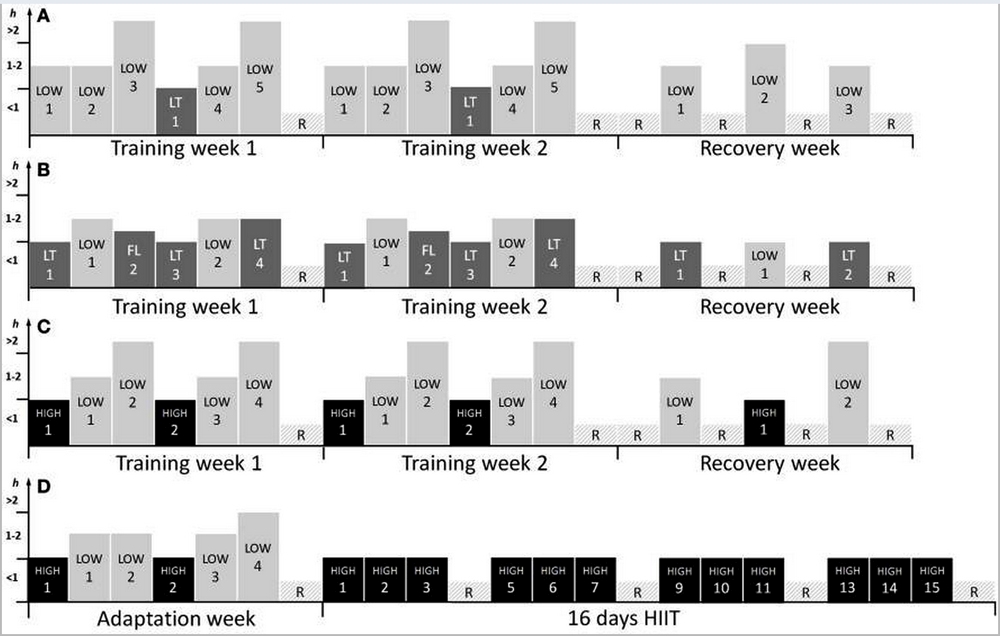
A: high-volume training (Low = low-intensity session, LT = threshold session; R = rest); B: threshold training (Low = low-intensity session, LT = threshold session, FL = fartlek session R = rest); C: Polarized training (Low = low-intensity session, High = high-intensity session, R = rest); D: Interval training (Low = low-intensity session, High = high-intensity session, R = rest); NB: Vertical axis = hours per session.
After nine weeks of training, the researchers looked to see what gains in endurance performance each mode of training produced. The findings were as follows:
- The polarized training regime (C) produced the biggest improvement in aerobic power (up by 11.7%), followed by high-intensity intervals (D) (up by 4.8%).
- The gains in peak power and times to exhaustion managed by the athletes in an incremental test were greatest in the polarized group (17.8% longer), followed by the high-intensity interval group (8.8% longer).
- The amount of power the athletes could produce at a blood lactate level of 4mmol/L (a measure of maximum sustainable power) was increased most in the polarized group (by 8.1%), and also increased in the high-intensity interval group (by 5.6%).
- With the exception of a slight increase in economy (a measure of muscle efficiency at sub-maximum workloads), neither the threshold training (B) nor the high-volume steady state training (A) protocols produced any significant performance gains!
Figure 3: training mode and % time spent in each zone(4)
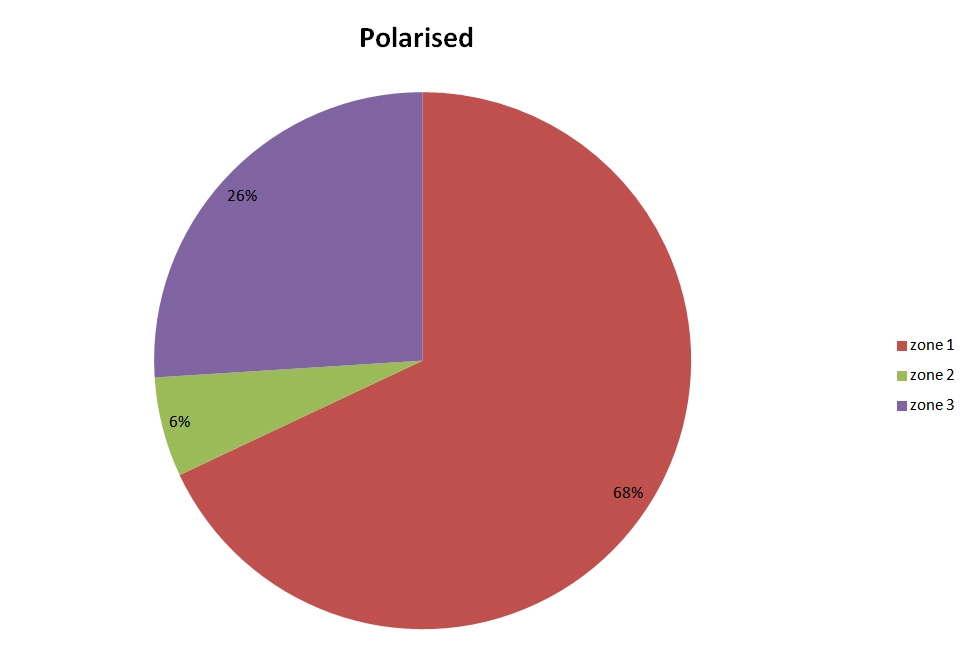
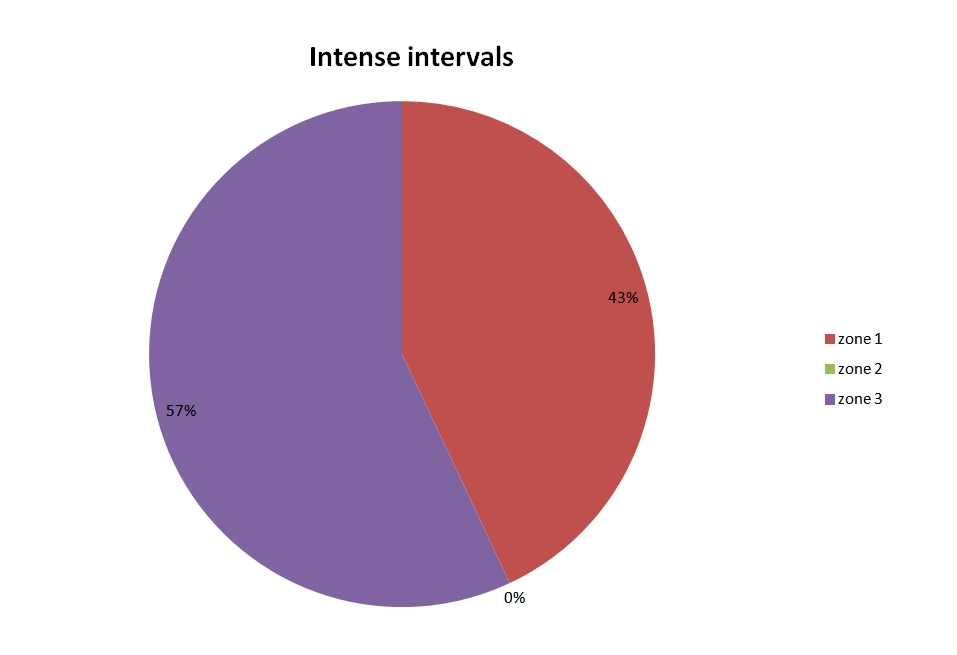
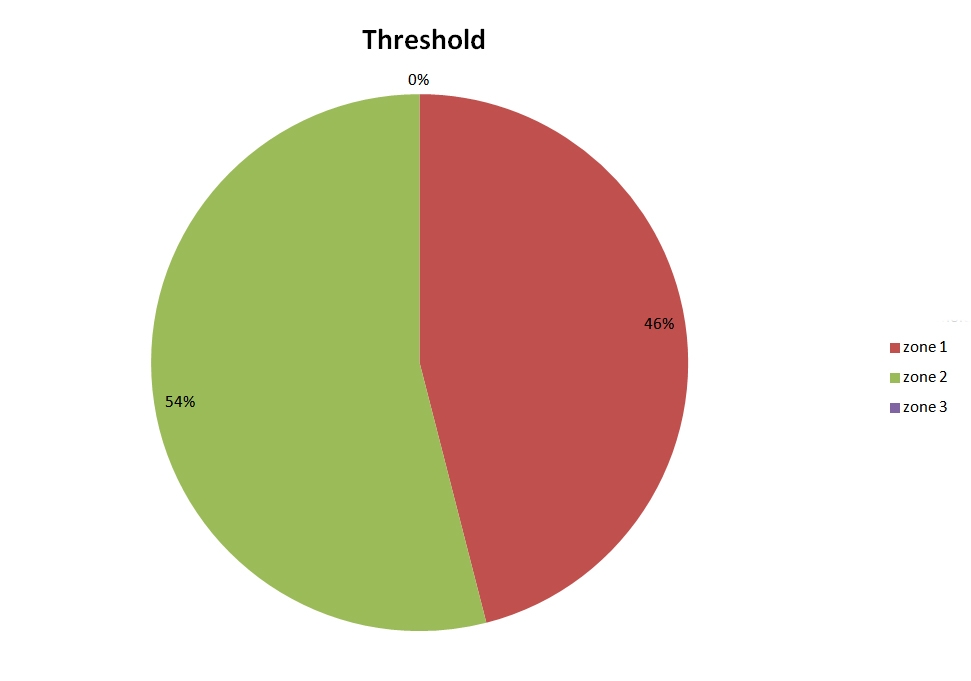
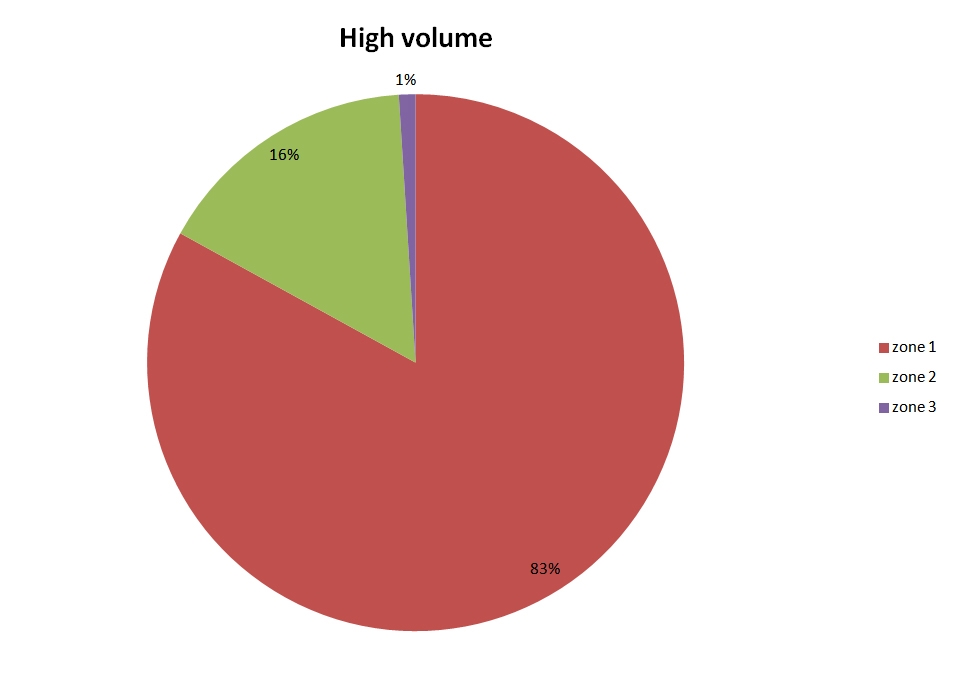
Polarized or intervals?
This study needs to be taken seriously because it used a large number of well-trained endurance athletes who correctly completed over 95% of their designated training sessions. The finding that a polarized approach to training was so effective should not perhaps come as a surprise as previous studies have demonstrated that a polarized approach is superior one dominated by relying solely on high-volume or dominated by lactate threshold training(5-7). What’s perhaps more surprising is that the polarized regime produced even bigger performance gains than the currently fashionable ‘high-intensity interval approach’, which used a larger volume of high-intensity work.The most likely explanation is that very intense training – ie in zone 3 – is able to significantly change the biochemistry of muscle cells in quite profound ways, specifically by activating ‘endurance genes’ in your muscles, boosting their activity. However, this activation is most effective when there’s a good aerobic base in place – ie as a result of lots of zone-1 training. Combining these two modes – ie polarized training – seems then to provide the best of both worlds.
High-intensity interval training, while providing lots of intense work, isn’t so effective at generating the all-important aerobic base that is achieved in polarized training. But it does seem to be a very useful training mode indeed for short periods – for example when time is tight, or during the off-season, when poor weather conditions and short days make it difficult to perform a decent volume of zone 1 work.
One thing that is abundantly clear however is that whatever else, some high-intensity work is absolutely vital for producing endurance performance gains. Take a look at the pie charts in figure 3 and you can see that the two least effective training modes (threshold and high-volume steady state) contained little or no zone 3 effort, yet ironically, this is how most amateur endurance athletes train most of the time!
Putting theory into practice
Let’s pull the strands together to provide some practical advice. Here are some best-practice training guidelines based on the published evidence. These assume you have already built up a decent level of base fitness and are looking to step your performance up a gear. If you don’t already do so, use a heart rate monitor to record your workouts so you can analyse the % of time spent in each of the 3 training zones. Collect some data and analyse your current training patterns to see where you spend most of your time. It’s common for athletes to discover that they spend quite a bit of time in zones 1 and 2, but very little in zone 3.If you compete or have major events planned for this summer, or are looking to see how you can improve next season, applying the following guidelines will likely yield good results:
- January – early March: Try and build up your base volume (zone 1). Occasional sessions of high-intensity intervals can be performed during the latter part of this period.
- Mid March to early summer: transition to a more polarized approach to your training. Aim for an 80:10:10 split between zones 1, 2 and 3 respectively. Towards the end of this period, consider performing a short block of high-intensity interval training, using passive rest in between each interval. Make sure however your total training volume is reduced accordingly to ensure you don’t become over fatigued.
- Summer season: if this is when you aim to peak, continue with a polarized training approach throughout. However, adding a little specific threshold work can be useful for judging race pace so long as it’s not performed in the run up to an important race or event. If you’re racing frequently and time is short, some sessions of high-intensity intervals can be useful at this time to maintain high levels of fitness.
- Early autumn: Continuing to use a polarized approach will help maintain your high levels of fitness.
- Late autumn/early winter: As the nights draw in and weather deteriorates, quality training becomes harder. Switch to base training and ease up on the volume. This is a time to allow the body deep rest and recovery and to recharge those batteries!
- All year round: if injury or illness forces you to take an extended layoff, resume with 2-3 weeks of base training before resuming intense work.
- Sports Med 38: 881-891, 2008
- Appl Physiology, Nutr Metab, 2008; 33 (6): 1112–1123
- J Strength Cond Res. 2013 May;27(5):1384-93
- Front Physiol. 2014 Feb 4;5:33
- J Appl Physiol. 2013 Feb 15;114(4):461-71
- Int J Sports Physiol Perform. 2012 Jun;7(2):103-12
- Int J Sports Physiol Perform. 2014 Jan;9(1):93-9
Newsletter Sign Up
Testimonials
Dr. Alexandra Fandetti-Robin, Back & Body Chiropractic
Elspeth Cowell MSCh DpodM SRCh HCPC reg
William Hunter, Nuffield Health
Newsletter Sign Up
Coaches Testimonials
Dr. Alexandra Fandetti-Robin, Back & Body Chiropractic
Elspeth Cowell MSCh DpodM SRCh HCPC reg
William Hunter, Nuffield Health
Keep up with latest sports science research and apply it to maximize performance
Today you have the chance to join a group of athletes, and sports coaches/trainers who all have something special in common...
They use the latest research to improve performance for themselves and their clients - both athletes and sports teams - with help from global specialists in the fields of sports science, sports medicine and sports psychology.
They do this by reading Sports Performance Bulletin, an easy-to-digest but serious-minded journal dedicated to high performance sports. SPB offers a wealth of information and insight into the latest research, in an easily-accessible and understood format, along with a wealth of practical recommendations.
*includes 3 coaching manuals
Get Inspired
All the latest techniques and approaches
Sports Performance Bulletin helps dedicated endurance athletes improve their performance. Sense-checking the latest sports science research, and sourcing evidence and case studies to support findings, Sports Performance Bulletin turns proven insights into easily digestible practical advice. Supporting athletes, coaches and professionals who wish to ensure their guidance and programmes are kept right up to date and based on credible science.
